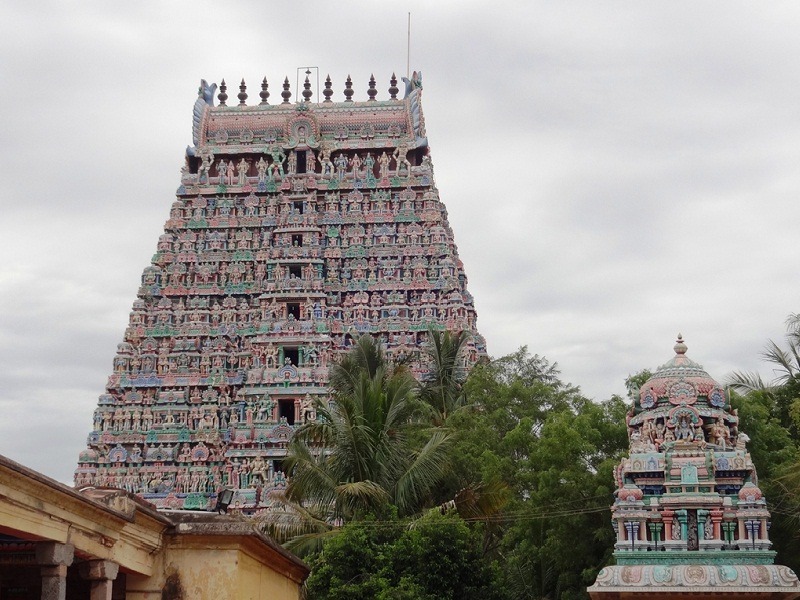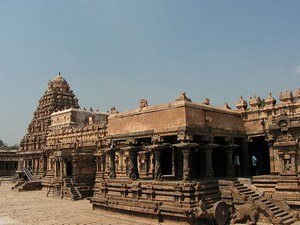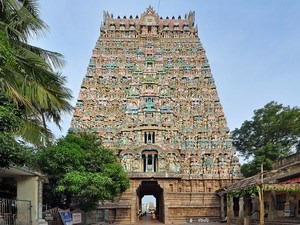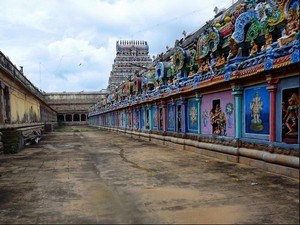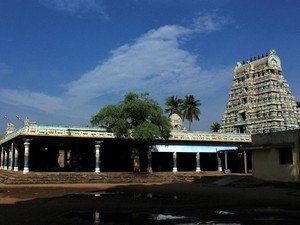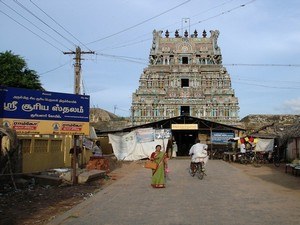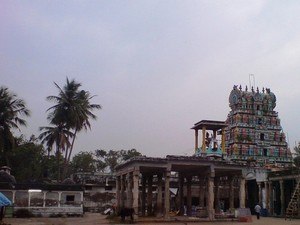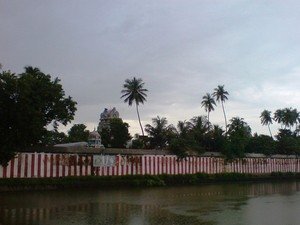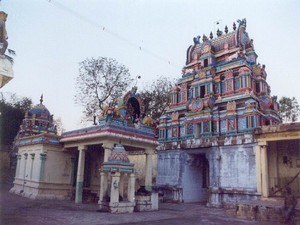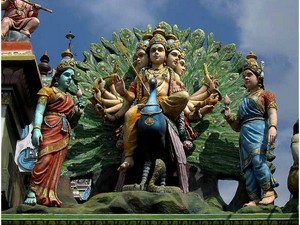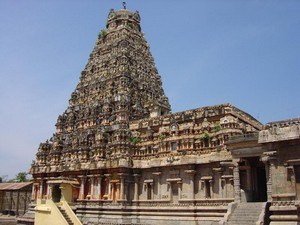Adi Kumbeswarar Temple, Kumbakonam - Timings, Festivals, History, Darshan, Pooja Timings
Photo Credit: Flickr
 India | TamilNadu | Kumbakonam
India | TamilNadu | Kumbakonam
 #1 of 30 Places to Visit in Kumbakonam
#1 of 30 Places to Visit in Kumbakonam
 Distance (From Kumbakonam Railway Station): 2.5 Kms
Distance (From Kumbakonam Railway Station): 2.5 Kms
 Trip Duration (Including Travel): 1 Hour
Trip Duration (Including Travel): 1 Hour
 Transportation Options: Cab / Auto
Transportation Options: Cab / Auto
 Travel Tips: None
Travel Tips: None
About Adi Kumbeswarar Temple
At a distance of 2.5 Km from Kumbakonam Railway Station, Adi Kumbeswarar Temple, also known as Thirukudamooku, is a famous Hindu temple located in the center of Kumbakonam in Tamil Nadu. Dedicated to Lord Shiva, it is one of the prominent temple in Tamil Nadu, and among the must include places in Kumbakonam tour packages. Lord Shiva is worshipped here as Adi Kumbeswarar, represented by a lingam, while his consort Parvati is honored as Mangalambigai Amman. The main deity is celebrated in the 7th-century CE Tamil Saiva scripture, the Tevaram, composed by the Tamil saint poets known as the Nayanmars. It is recognized as the 26th Paadal Petra Sthalam within the Chola dynasty, which extended south of the River Cauvery.
History of Adi Kumbeswarar Temple
Among the top pilgrimage sites in Tamil Nadu, Adi Kumbakonam Temple was constructed in the 9th century CE, during the Chola dynasty. The temple underwent renovations by the Nayakas of Thanjavur between the 15th and 17th centuries, with significant contributions from Govinda Dikshitar, the Chieftain under Achutha Nayakar of Thanjavur, who was instrumental in the 16th-century restoration efforts. Today, the temple is overseen and managed by the Hindu Religious and Charitable Endowments Department of the Tamil Nadu Government.
Mythology of Adi Kumbeswarar Temple
The town of Kumbakonam derives its name from a legend linked to the Adi Kumbeswarar Temple. According to the myth, following a catastrophic tsunami that devastated the world, Lord Brahma asked Lord Shiva, from where he can restart creation. Lord Shiva advised him to create a magical pot using sand gathered from various holy sites and to set it adrift in the floodwaters. Kumbakonam is identified as the location where the pot came to rest, after which Lord Shiva, disguised as a hunter, shot an arrow at it. This action caused the nectar (amirtham) to spill out, mingling with the sand and forming a Linga, which is revered as the principal deity of the Adi Kumbeswarar Temple. It is believed that the nectar fell into two specific locations: the Mahamaham tank and the Potramarai tank. This significant event is celebrated during the Mahamaham festival, which occurs every 12 years.
Architecture of Adi Kumbeswarar Temple
The Adi Kumbeswarar Temple stands as a remarkable example of Dravidian architecture. The temple complex is designed in a rectangular layout with an East-West orientation, encompassing approximately 4 acres. It features three Prakaras: Aswametha Pradakshina, Kodumudi, and Pranava, along with four gopurams. The eastern gopuram is the tallest, boasting 11 stories and reaching a height of 128 feet, complemented by smaller gopurams to the north and west, and a domed gopuram in the south. A corridor extends from the eastern gopuram to the main temple.
Within the temple, there are numerous shrines, with the most significant being those of Adi Kumbeswarar and Mangalambigai Amman. The main deity, Adi Kumbeswarar, is represented as a lingam, which is believed to have been created by Shiva himself using a mixture of nectar of immortality and sand. This Shiva Linga is wider at the base and tapers to a point at the top, resembling a needle. The shrine of Mangalambika is situated to the left of Kumbeswarar, while Somaskanda is positioned to the right. The first precinct surrounding the sanctum features images of Appar, Sambanthar, Sundarar, and Manickavasagar, along with representations of the sixty-three Nayanmars, Virabhadra, Saptakannikas, Visalakshi, Visvanatha, Karthikeya, Annapurneswari, Vinayaka, Gajalakshmi, Mahalakshmi, Saraswathi, Durga, Chandikesa, Nandi, and Nataraja. Notably, the idol of Subramanya has six hands instead of the usual twelve, and the temple also showcases stone nadasvarams and Kiratamurti as key attractions.
The temple complex includes several halls, with the Navaratri Mandapam, also known as the 16-pillared hall from the Vijayanagara period, being particularly noteworthy. This hall features intricate carvings of all 27 stars and 12 zodiac signs on a single stone. Lord Ganapati, Lord Muruga, and Kiratamurti are the other shrines present at this temple. The Mahamaham tank, Potramarai Tirtha, Varuna Tirtha, Kasyapa Tirtha, Chakra Tirtha, Matanga Tirtha, and Bhagavad Tirtha are the seven outlying water bodies associated with the temple. There are five silver-plated chariots in the temple used to carry the temple deities during festive occasions.
Festivals of Adi Kumbeswarar Temple
The Mahamaham festival that takes place once every twelve years during the Tamil Month of Masi (February/March) is the greatest religious festivals celebrated in Adi Kumbeswarar Temple when lakhs of pilgrims from various parts of India visit Kumbakonam to take a holy bath in the sacred Mahamaham tank. The other major festivals celebrated here are Maha Shivaratri in February/March, the Butter Pot festival in February/March, Chithirai Brahmotsavam in March/April, Adi Pooram in July/August, Thirukalyanam in May/June, Masi Magham, and Thai Poosam Star float festivals.
Adi Kumbeswarar Temple Dress Code & Other Restrictions
When planning a visit to the Adi Kumbeswarar Temple in Kumbakonam, it is recommended to adhere to modest clothing that covers your upper arms and legs as a sign of respect. Men are encouraged to wear a dhoti or pajama paired with an upper garment, as well as formal trousers and shirts. Women may opt for a saree, half saree, or churidhars. It is advisable to refrain from wearing contemporary attire such as mini-skirts, low-waist jeans, shorts, and sleeveless tops while on the temple grounds.
Non-Hindus are welcome to explore the temple complex and appreciate its architectural beauty; however, access to the sanctum sanctorum may be restricted.
Adi Kumbeswarar Temple Timings
Monday: 6 AM - 12:30 PM & 4 PM - 9 PM
Tuesday: 6 AM - 12:30 PM & 4 PM - 9 PM
Wednesday: 6 AM - 12:30 PM & 4 PM - 9 PM
Thursday: 6 AM - 12:30 PM & 4 PM - 9 PM
Friday: 6 AM - 12:30 PM & 4 PM - 9 PM
Saturday: 6 AM - 12:30 PM & 4 PM - 9 PM
Sunday: 6 AM - 12:30 PM & 4 PM - 9 PM
Adi Kumbeswarar Temple Entry Fee
General Entry is Free
Special Darshan available for Rs. 30
Best Time to Visit Adi Kumbeswarar Temple
The best time to visit Adi Kumbeswarar Temple is from October to March, while the peak season is from November to February. The Mahamaham festival that takes place once every twelve years during the Tamil Month of Masi (February/March), Chithirai Brahmotsavam in March/April, Adi Pooram in July/August, and Thirukalyanam in May/June offers a remarkable opportunity to immerse oneself in the temple's lively ambiance, drawing thousands of devotees. It is advisable to avoid visiting the temple in the peak summer months from April to June, as temperatures can rise significantly, complicating outdoor activities.
How to Reach Adi Kumbeswarar Temple
Trichy Airport serves as the closest airport, located approximately 95 kilometers from Kumbakonam. The Kumbakonam Railway Station offers extensive train connectivity to various cities, including Chennai, Rameswaram, Kanyakumari, Pondicherry, Mysore, Mayiladuthurai, Thanjavur, Trichy, Bhubaneswar, Madurai, Coimbatore, Tirupati, Bangalore, and Thirunelveli. Additionally, bus services are available to Kumbakonam from all regions of Tamil Nadu. To reach the Adi Kumbeswarar Temple, one can take a bus or hire an auto-rickshaw or cab from anywhere within Kumbakonam.



